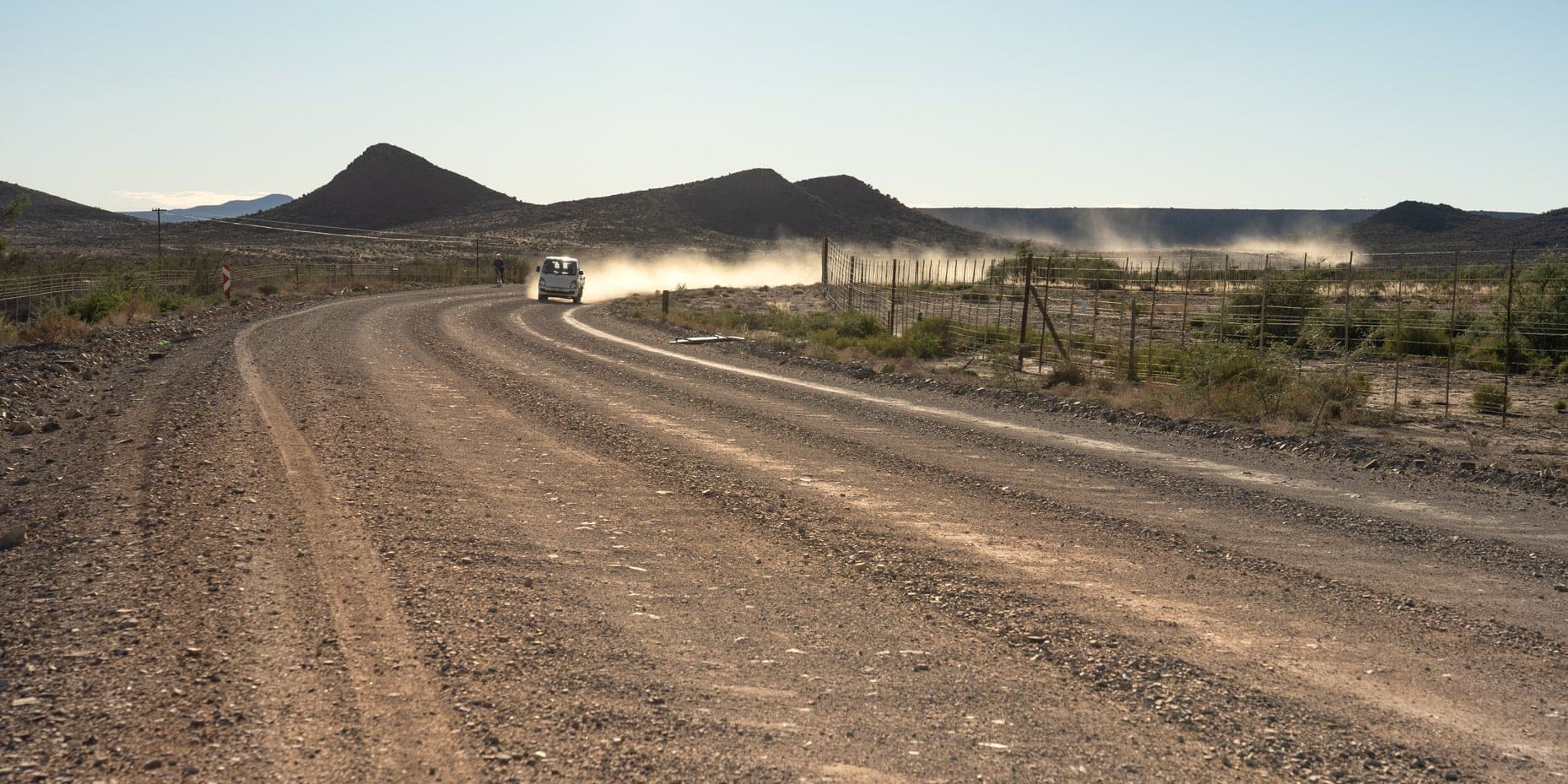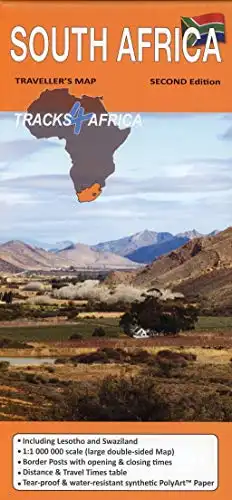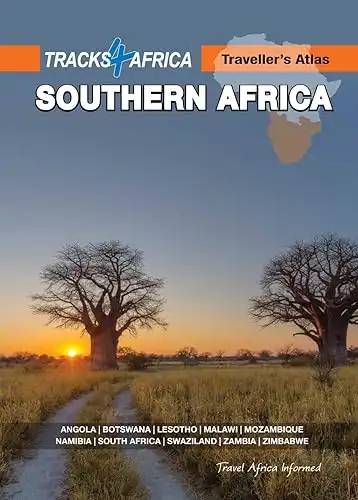Embarking on a road trip or self-drive safari in South Africa? Our definitive guide on driving in South Africa is here to help you navigate the myriad challenges you might encounter.
Knowing the local driving laws, understanding vehicle requirements, and adhering to safety precautions are essential—especially for tourists unfamiliar with the country. Drawing from our extensive personal experiences and thorough research, this guide offers reliable advice to ensure you safely explore South Africa’s diverse landscapes.
We’ve navigated these roads, faced uncertainties, and learned valuable lessons.
This article addresses the hard-hitting questions and equips you with the essential knowledge and practical tips needed to navigate safely through South Africa’s stunning landscapes.
Quick Start: Key Information and Safety Tips For Driving in South Africa
- Drive on the left-hand side and overtake on the right.
- Traffic lights, locally known as ‘robots’, often malfunction during power outages. In such cases, treat the junction as a 4-way stop.
- Roundabouts, known as ‘circles’, have traffic approaching from the right.
- At 4-way stop intersections (all marked with red stop signs), the first vehicle to arrive has priority
- Seat belts are compulsory.
- The legal limit for blood alcohol content is 0.05%.
- Mobile phone use: Only use hands-free devices while driving.
- Beware of South African minivan taxis. Their drivers, often in a rush to earn more by completing trips quickly, are notorious for reckless driving and running stop signs.
- Speed limits, unless otherwise marked, are as follows:
- Highways and major routes: 120 km/hr
- Secondary and rural roads: 100 km/hr
- Built-up areas: 60 km/hr
- National Parks: 35-40 km/hr
- Cyclists must be provided a distance of 1.5m from your vehicle.
- All traffic signs are in English.
- Google Maps gives reliable driving times for tarred roads but not for 4×4 routes
- The emergency number accessible from mobiles is 112.
Vehicle Hire Options
- Hire a standard 2×2 car: Find a deal at DiscoveryCars. com
- Hire a bush camper: Find the best deal at Motorhome Republic (They deal with many different South African Fleets to find the best price and option for you) or Contact Bushlore, South Africa for a quote.
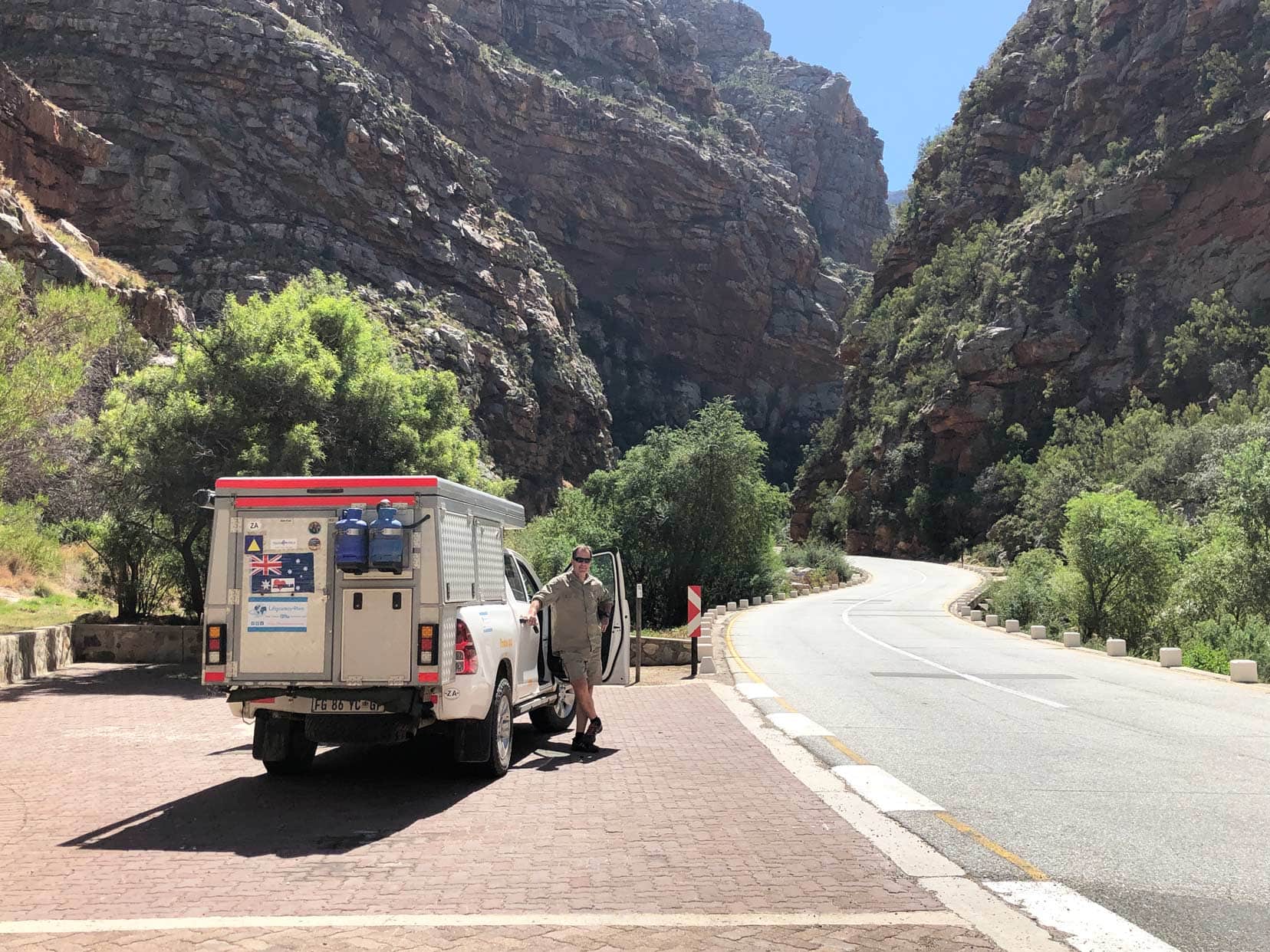
What’s in this article?
Here are the questions you’ll want answered as you prepare to drive in South Africa:
- 🚗 Is driving in South Africa safe for tourists?
- 🦺 What are the safety guidelines while travelling on South African roads?
- 📽️ Video: Crazy Overtaking on South African Roads
- 🚦 What are the South African road rules and regulations?
- 🛣️ What are the road conditions like in South Africa?
- 🏞️ What are the National Park’s Driving Rules?
- 🚙 What type of vehicle is best for driving in South Africa?
- 🤔 What are the rules for crossing South African borders?
- 💉 What vaccinations do I need to arrive in South Africa?
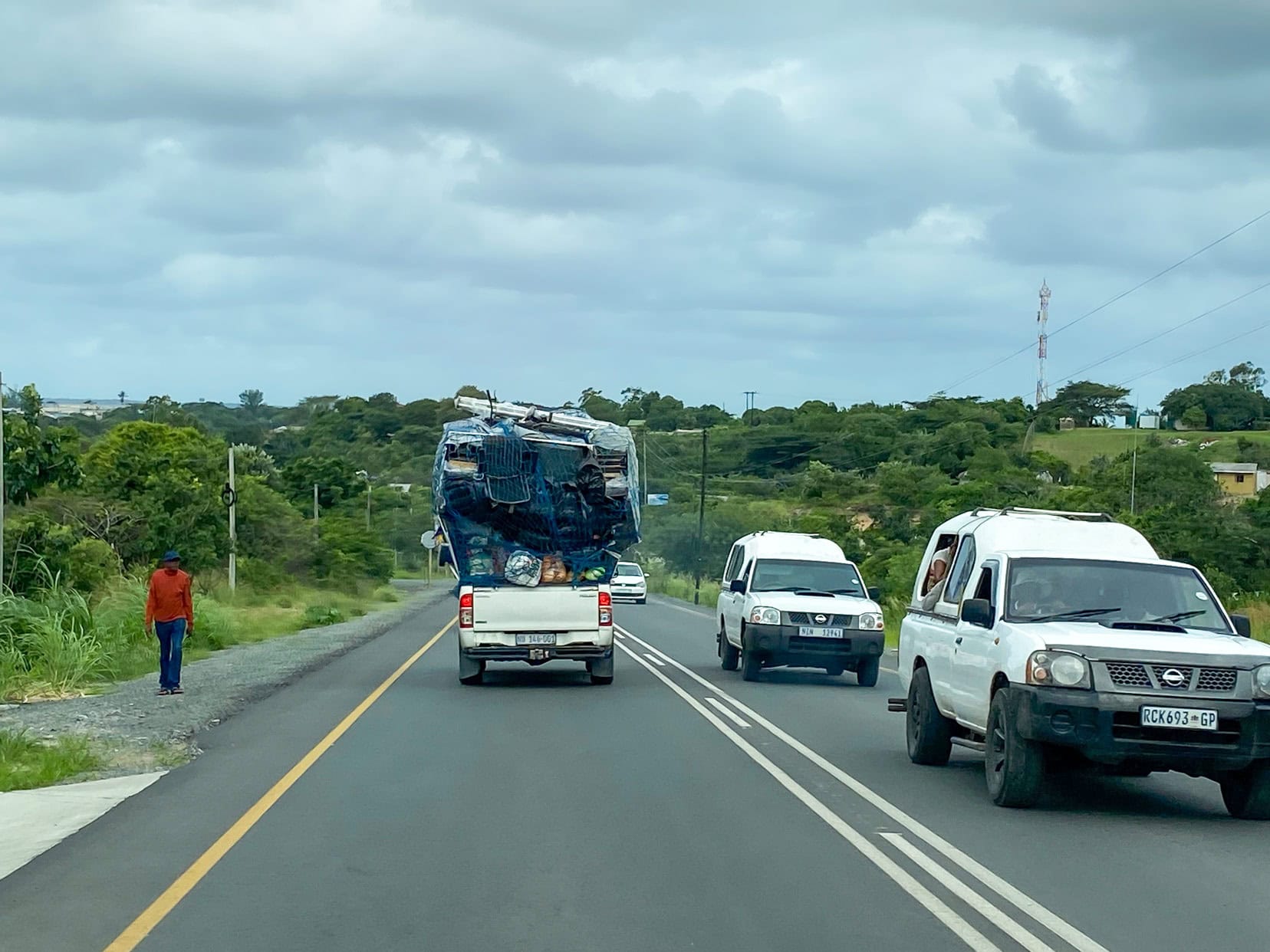
Planning a Trip to South Africa?
- 🚗 Hiring a car? We recommend getting a quote from DiscoverCars
- 🚐 Hiring a campervan? We recommend Motorhome Republic
- ⛑ Arranged your travel insurance? Compare quotes from World Nomads & Safetywing
- 🪪 Order your International Driver’s Licence online here
- 🏩 Booked your accommodation? We use Booking.com to find the best deals
- 🐾 Is someone pet-sitting for you? 🐾 We use and love TrustedHousesitters
- (Get 25% off at checkout for new memberships with our discount code: LIFEJOURNEY25)
Map: South Africa
Safety First: Is Driving In South Africa Safe For Tourists?
One of the main concerns for most visitors to South Africa is whether it is safe to drive there and concern about their personal safety. Before we arrived, we were offered advice on precautions, which locals echoed and added to when we arrived.
We’ve included all of those suggestions in this article.
For clarity, some of these precautions are particularly important to adhere to when driving in the major cities, Johannesburg, Pretoria, Cape Town and Durban.
In the cities, many houses are walled with barbed wire and have security gates. In more rural areas, the probability of crime decreases, and the deterrents, while less visible, are still evident.
The population of South Africa is a complex and diverse mixture consisting of six main tribes: Afrikaans, English, Nguni (Zulu, Swazi, Xhosa and Ndebele), Sotho, Shangaan-Tsonga and Venda.
This does not include other tribes from different African nations residing in South Africa. Tensions are evident.
Trouble areas can arise overnight, and the best way to know how to avoid them is to ask one of the locals.
Trusting your gut instinct is something we always use – a feeling we don’t ignore. If the area feels dodgy, move on.
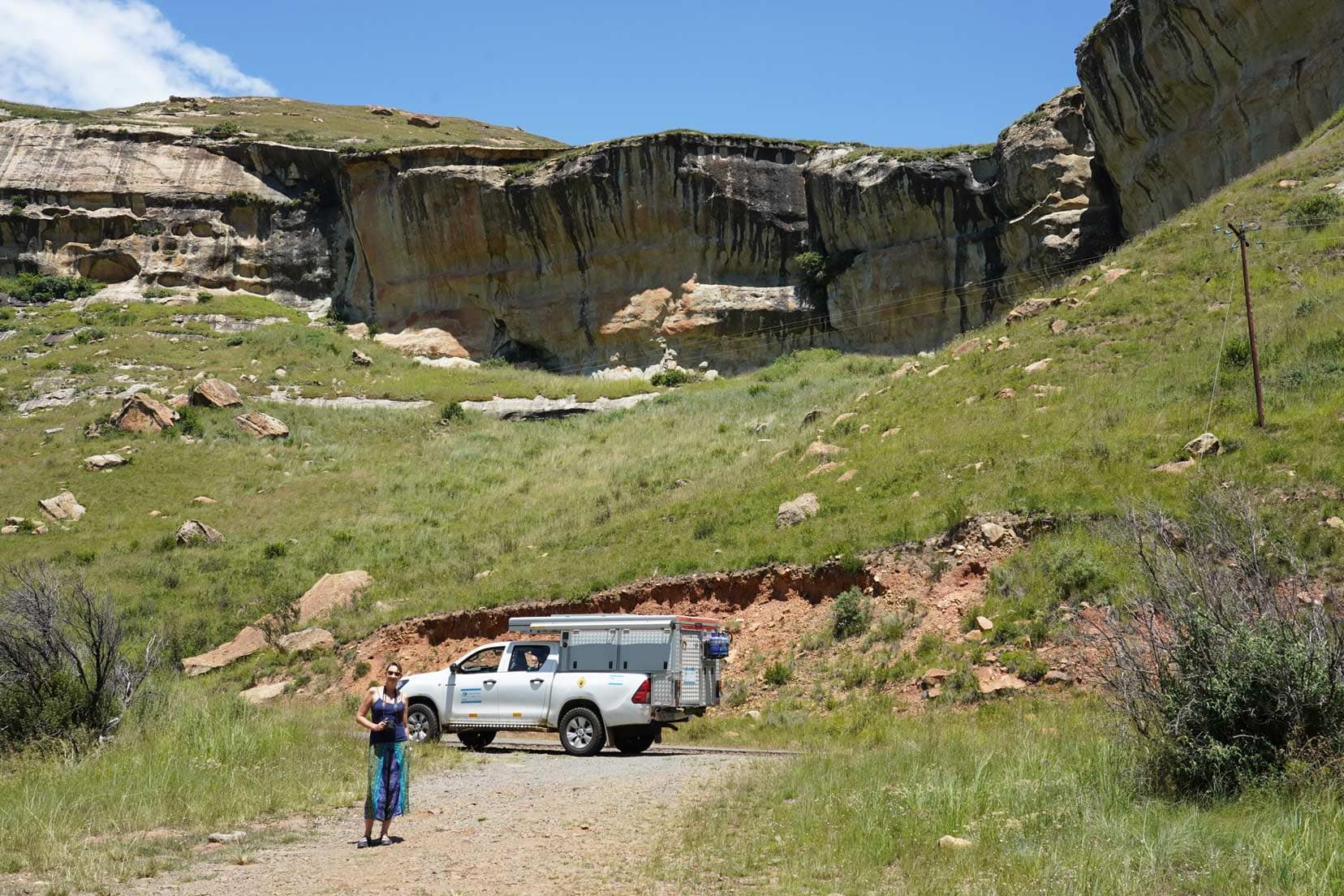
Safety Guidelines While Driving In South Africa:
- Do not drive at night
- There is a higher risk of hold-ups and robbery at night. In Jo’Burg, we saw signposts informing us of: ‘hijacking area next 5 km’. No, we didn’t stop to take photos of the sign.
- Wild animals are more active at dawn and dusk, so there is an increased likelihood of encountering animals on the road.
- Don’t stop at red lights at night
- If you must drive at night, avoid stopping at red traffic lights (robots). Slow down, remain in first gear, and check for oncoming traffic. Be aware of anyone pulling up beside you, and keep enough distance between you and the car in front so that if you need to escape quickly, you can. Stay on your guard.
- Keep your doors locked and windows up while driving
- This is especially important if driving through the cities or townships around the major cities.
- Leaving a small gap at the top of your window is safer; as in not fully closed, so we’ve been told. This apparently makes it harder for the glass to break. (Thieves commonly throw a small piece of spark plug ceramic at the window to cause the break). There is window smash-and-grab protection that may be worth considering.
- Do not stop if you see an accident
- Although this seems counterintuitive to what you would do in your home country, drive on and make a call or stop at the nearest shop café to report the incident. Hijackers and thieves have been known to stage an accident to get you to stop.
- Drive around rocks or an obstacle on the road — do not stop
- Again, hijackers or thieves will place obstacles (such as rocks and branches) on the road to get you to stop.
- Do not pick up hitchhikers
- If you are worried about someone’s plight, stop at the next town and report it to someone there.
- Do not open your window to speak to anyone who may be at a junction
- Hawkers, window cleaners, etc., may approach your vehicle at junctions. Keep eye contact and give a polite, firm shake of the head. Keeping eye contact, reduces the time they can scout the inside of your car.
- Do not leave expensive items in your vehicle — or at least not in view
- Don’t leave expensive items in your vehicle; however, in some situations, this is unavoidable. If you do need those items with you (our vehicle is our home – so we always have all our equipment with us), then make sure your valuables are securely locked away or at least out of sight.
- If you are in a camper, ensure all access points and storage sections are locked, and removable items are pad-locked. This ensures that you are not an easy target for theft.
- If you have exterior gas bottles, padlock them.
- Always check your doors are locked after locking your vehicle
- Criminals use car lock-jamming devices. Always check that your car is locked when using the remote by testing the door handle or locking your vehicle with the key.
- Do not confront aggressive or abusive road users
- Ask locals for advice
- Situations change, so ask locals about any safety concerns you should be aware of and any areas that they recommend you avoid.
The chances of a hijack increase particularly in the provinces of Gauteng and Kwa Zulu Natal. Statistics show that there are more hijacks on a Friday than any other day of the week and the majority occur between 4 pm and 8 pm.
For further information, read this Hijack Prevention Guide by Arrive Alive South Africa.

You can take different actions to minimize theft of belongings in your vehicle and prevent damage while driving in South Africa. The relevance of these pointers may vary depending on the duration of your trip, the locations you plan to drive through, and whether the vehicle is owned or rented.
From our experience, the only people we have encountered who experienced car crime were locals living in Johannesburg. We haven’t heard of any travellers facing similar issues.
You will likely remain safe by following these guidelines and taking sensible precautions.
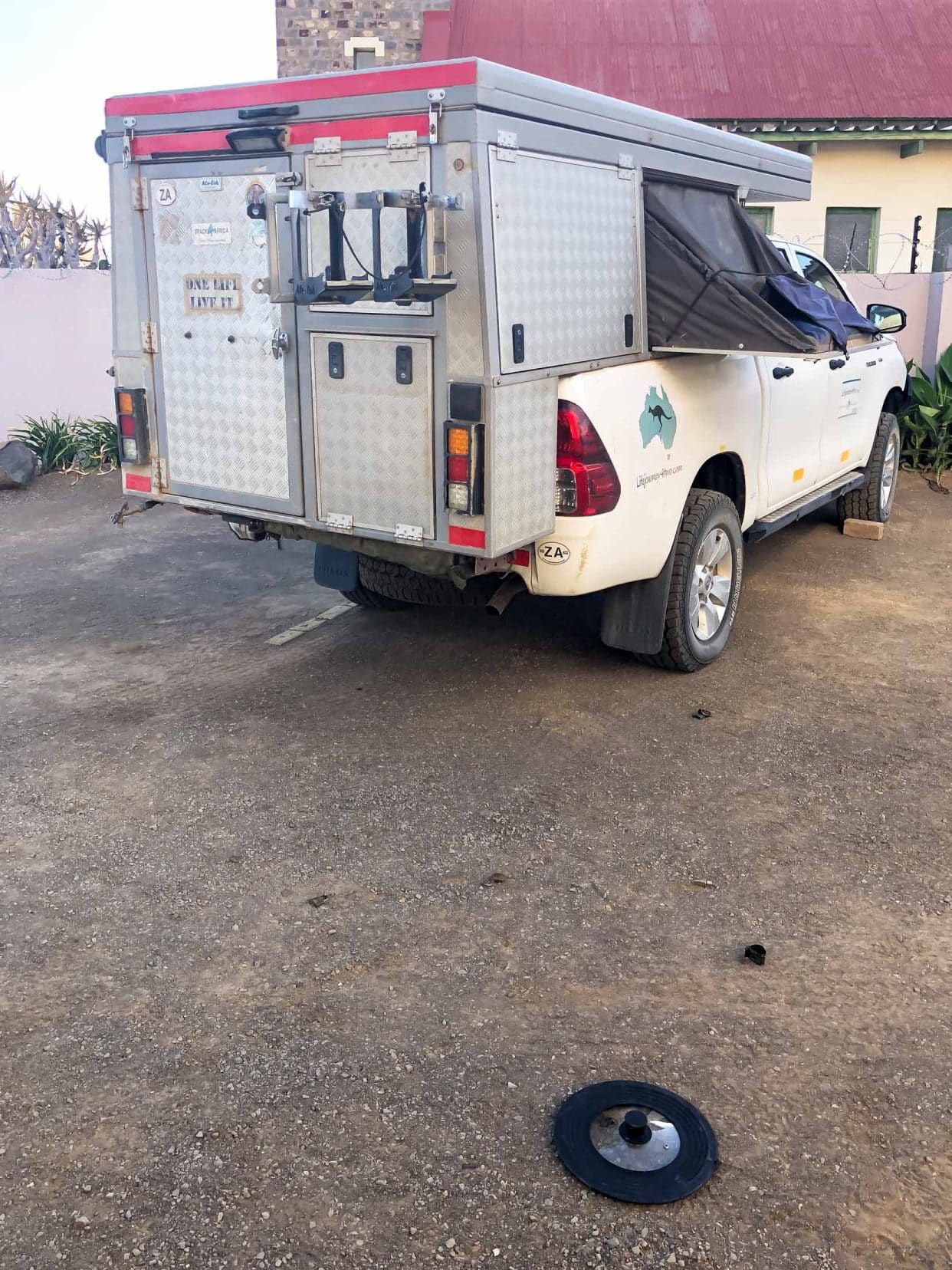
⛑ Arranged your travel insurance? Compare quotes from World Nomads & Safetywing
Video: 🤪 Crazy Overtaking Maneouvre on South African Roads
The big question: is it safe to drive in South Africa? Sometimes … South Africa driving at its best. Any driving tips you could recommend here? Drop us a comment below.
South Africa Driving Rules and Regulations
Before you hit the road, you need to familiarize yourself with the specific rules and regulations governing driving in South Africa.
Driving Documents Required
When you arrive in South Africa, you need a valid passport with at least 6 months of validity remaining from when you plan to leave the country.
Visitors get a 90-day Visitor Visa. As Australians, we didn’t need a visa before entering South Africa and received the 90-day visa stamp at border control at the airport.
You can check whether you need a visa at the South Africa Immigration website.
Regulations state that a return ticket is necessary, but we didn’t have one and weren’t asked to show one. We had prepared for that question, though, and had recent copies of our bank statements to show that we could support ourselves while in South Africa.
We didn’t need to show them, but we’d suggest printing them anyway … just in case.
When driving in South Africa, you must keep the following documents in your vehicle at all times:
- a valid driver’s licence,
- vehicle registration documents and
- vehicle insurance documents.
If you are hiring a vehicle, check with the individual company that you have the relevant documentation you require.
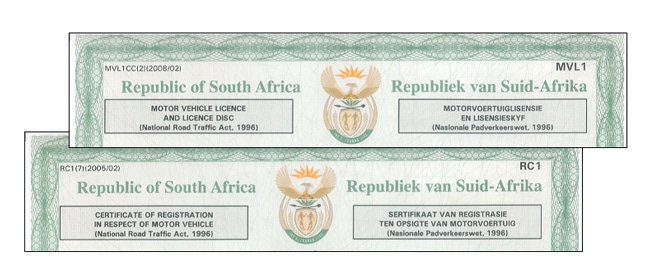
Driving In South Africa With A Foreign Licence
Your foreign Driver’s Licence is valid in South Africa if:
- Your driver’s license is in English
- It has a photo ID attached
- It has your signature
Otherwise, you need a translation of your licence by an authorised person. Even though we satisfy the criteria with our Australian Driver’s Licences, we also ensured we had an International Driver’s Licence before deaprting Australia.
Again, just to be on the safe side. You can read the South Africa Foreign Driving Licence regulations here.
South African Road Signs
There are lots of direction signs in South Africa and most are similar to those found around the world. To familiarise yourself with the traffic signs click here.
A few we came across that we weren’t familiar with were:
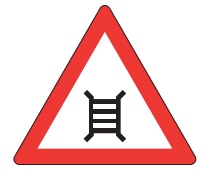
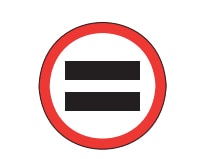
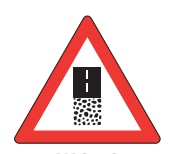

Driving Etiquette: Overtaking and The Yellow Shoulder
On some roads, there is a hard shoulder marked by a yellow line. You often see slower vehicles move to the left side of their lane and even cross the yellow line to allow faster vehicles to overtake more easily.
It’s certainly not unusual for a two-lane road to become a three- or four-way road.
You will notice that most drivers are polite and will flash their hazard lights after overtaking as a thank you.
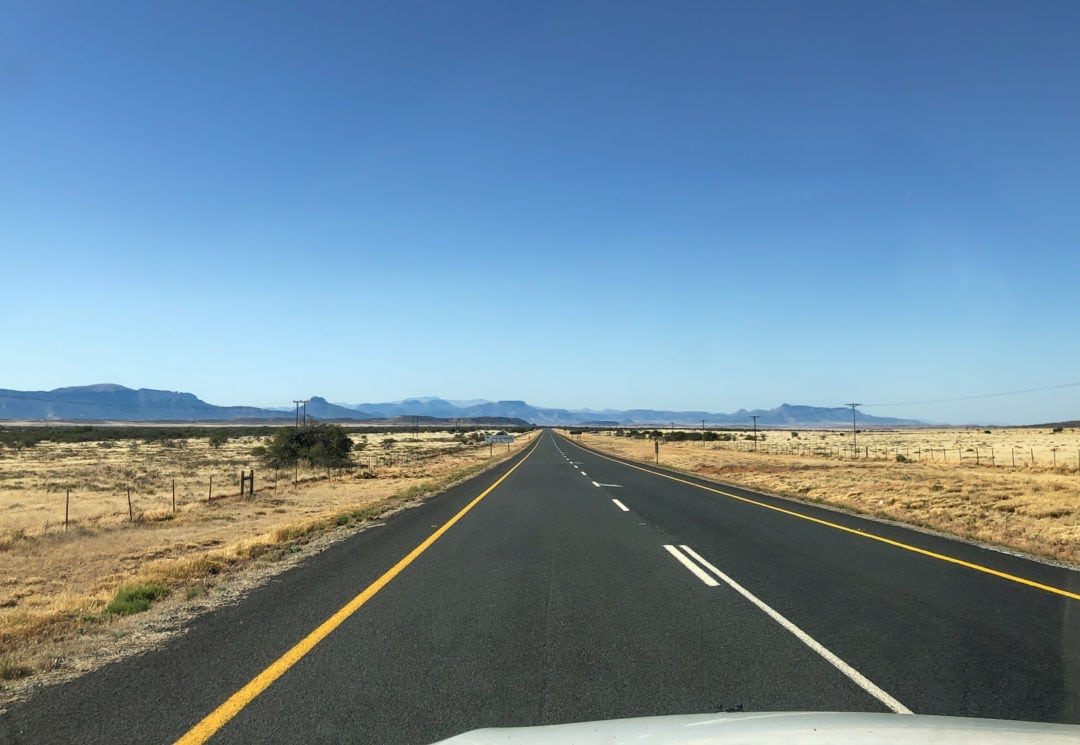
A solid single, solid double or a solid double with dashes in between indicates no overtaking/no crossing.
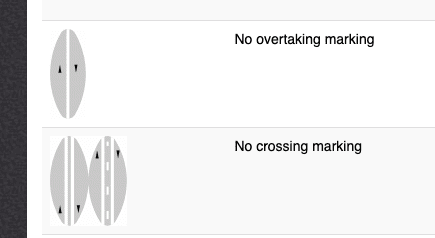
What To Do If You Have A Road Accident In South Africa
As per the Road Traffic Law in South Africa (see page 16 PDF – Amendment of section 61 of Act 93 of 1996 ), if you are involved in a road accident and someone has been injured, or property has been damaged, such as a vehicle or animal, it is law in South Africa to:
- Stop your vehicle
- Help anyone who is hurt (if safe to do so)
- Find out the extent of the damage
- Obtain all relevant information relating to the crash and take photos if possible
- Report the road crash to the police. The police will need an AR (Accident Report Form) filled out – See a sample copy here
- Do not interfere with the evidence on the scene
- Do not leave the scene if any injuries or fatalities are observed
If driving a rental car, keep all paperwork handy and have any relevant numbers you need to call in case of an accident.
Roadblocks
During your travels in South Africa, you could encounter a roadblock. This is where the South African police pull cars over to inspect your vehicle documents.
Your driver’s licence and vehicle ownership or rental papers and any other relevant documents will be requested.
Police may ask to look inside your vehicle. If you have a 4×4 camper, like us, they may ask you to open the back for a visual inspection.
This can take a while. Remain patient. Luckily we’ve not had any problems when we’ve been stopped.
Occasionally, police will ask to see our driver’s licence and passport, but normally it’s just our driver’s licence.
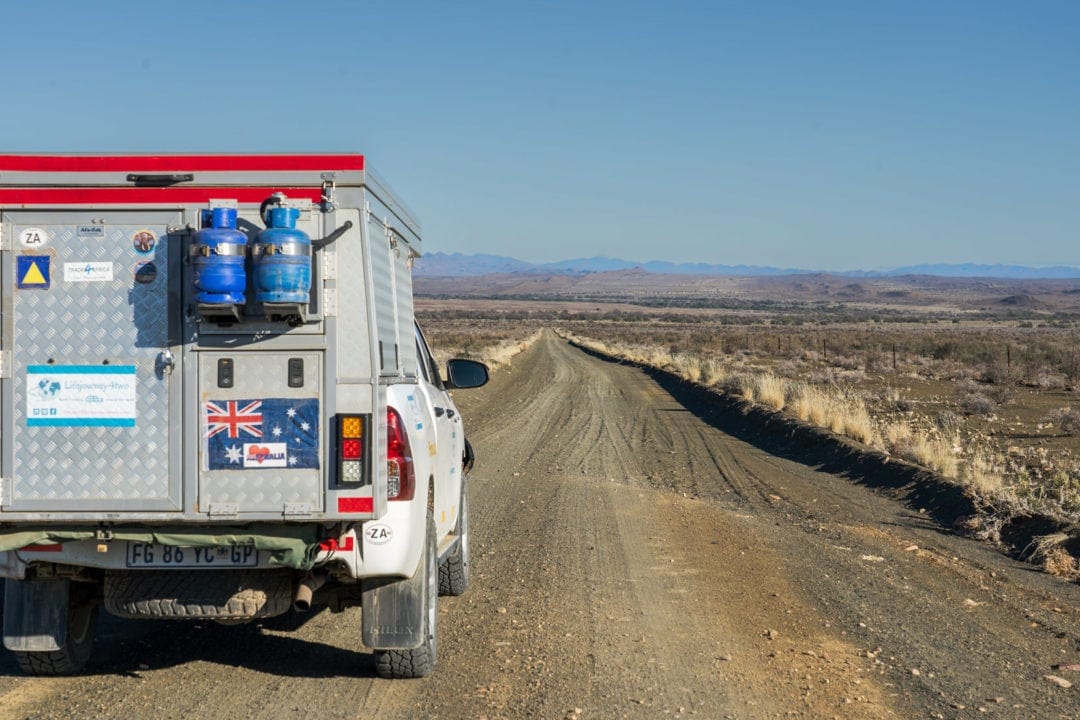
Road Tolls
Some of South Africa’s main highways have a toll, but you’ll find they are clearly marked well before you reach the toll. This gives you an opportunity to divert to a non-toll road.
Most tolls take credit cards, but due to load shedding (power cuts), cash is best. If you’ve rented a vehicle, it should have an electronic e-Toll tag that records your fees, which you pay when you return the vehicle.
We prefer to avoid toll roads, and with the country’s many minor roads, this is easy to do when driving in South Africa.
For more information on Toll Roads and prices, you can check out Automobile site.
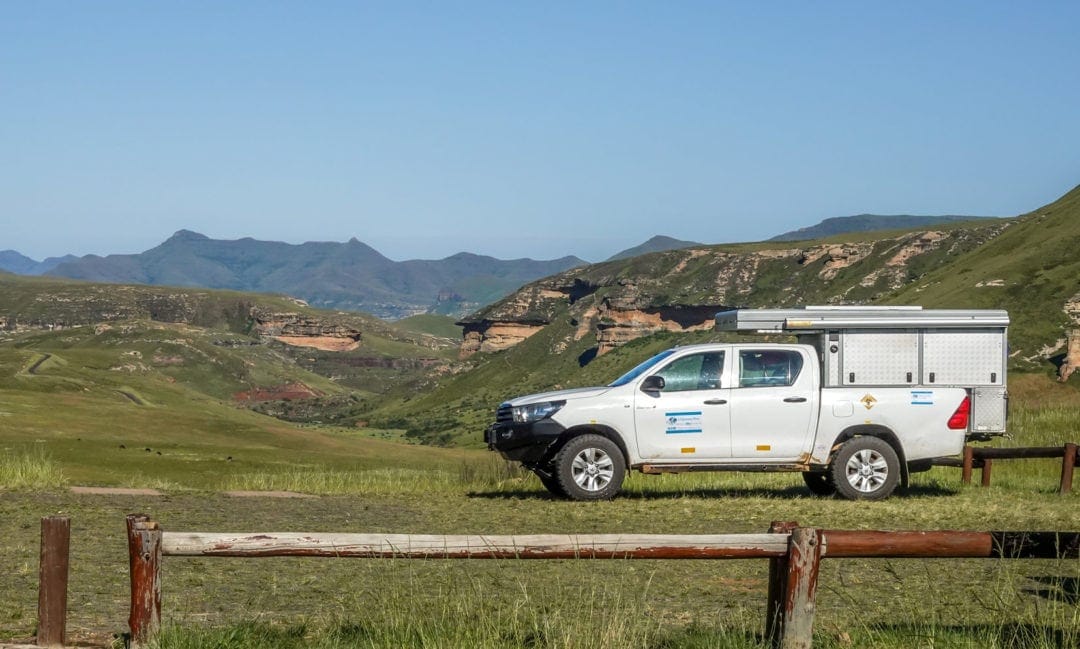
Road Conditions in South Africa
Most of the roads in South Africa are reasonably well-maintained. However, you are more likely to experience gravel and dirt roads in rural areas. During heavy rains, roads can be damaged by landslides or flooding.
The Automobile Association of South Africa (AA) provides up-to-date information on roadworks and closed roads. You can enter your planned route, and it will highlight the road conditions for those roads.
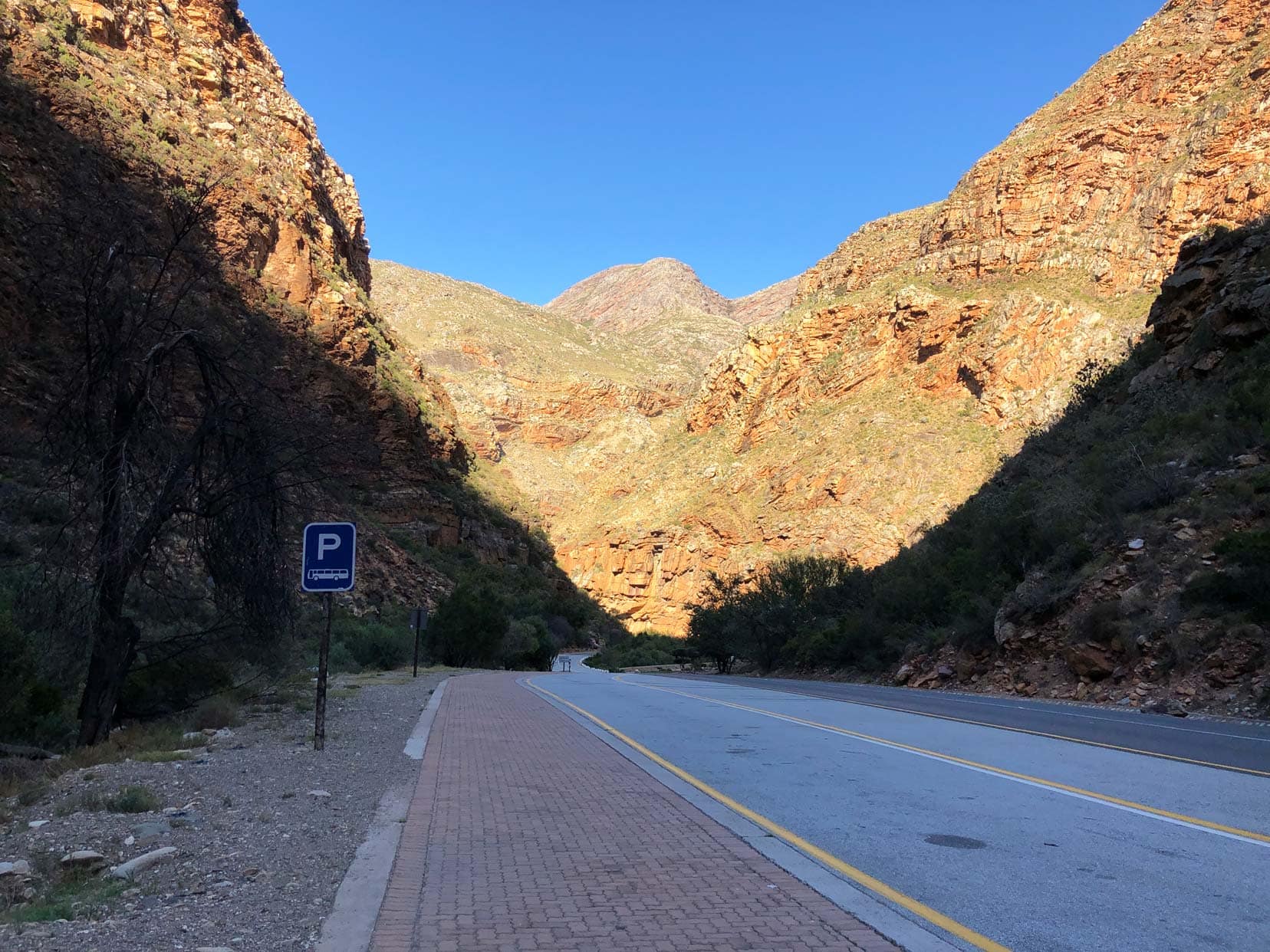
We’d be lost without our Tracks4Africa products. They have a great range of paper maps, road atlas and other practical items that any overlanding adventurer should be equipped with.
This Tracks4Africa is a fold-out map with accurate driving distances and times for sealed roads and 4x4 routes. Other helpful info includes campsites, fuel stops, supermarkets and much more.
Gas/Petrol Stations
Nearly all of South Africa’s service stations are manned by pump attendants. When you stop at a fuel bowser, the attendant comes to your machine to discuss the type of fuel, how much you want and if you will pay by cash or card.
Sometimes, you can pay by card without leaving your car as the attendant has a card machine. Sometimes, and if you pay in cash, you pay at the counter.
The attendants may also clean your windows and check your tyre pressure. It’s usual to give them a tip between two and five Rand.
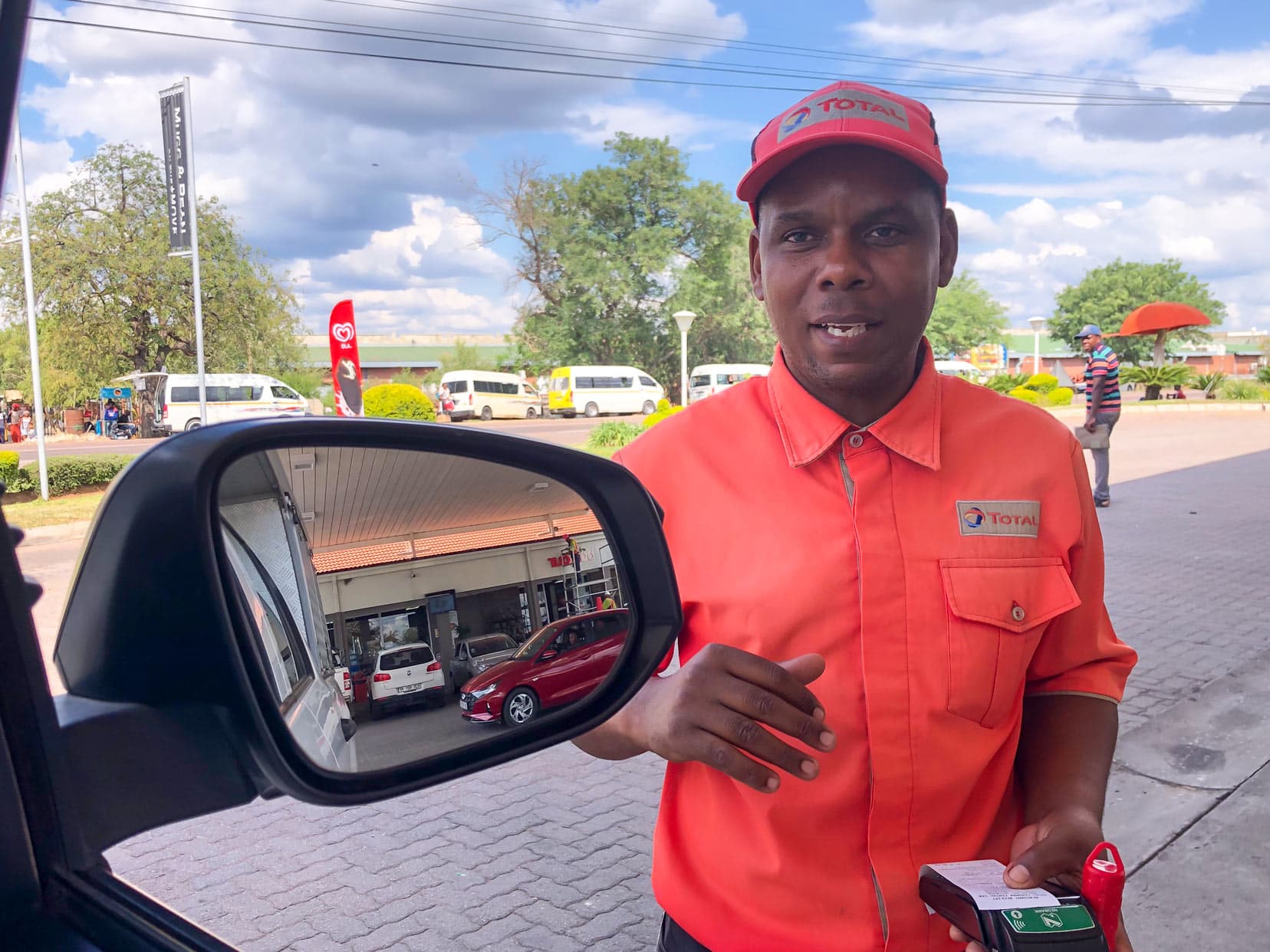
In South Africa, there are plenty of fuel stations, but we would advise using the main gas stations only: Engen, Shell, BP, Sasol, Total and Caltex. We were told by a local that fuel at Coop stations, dotted throughout South Africa, are one of the cheapest places to purchase fuel.
Some of the smaller fuel stations may have suspect fuel, which could harm your engine. We had a similar problem, and it was costly to empty and clean the fuel tanks and replace parts of the fuel injection system.
If you travel to neighbouring countries, be aware that there may be long distances between available petrol stations and with limitations on fuel, not all pumps will be available.
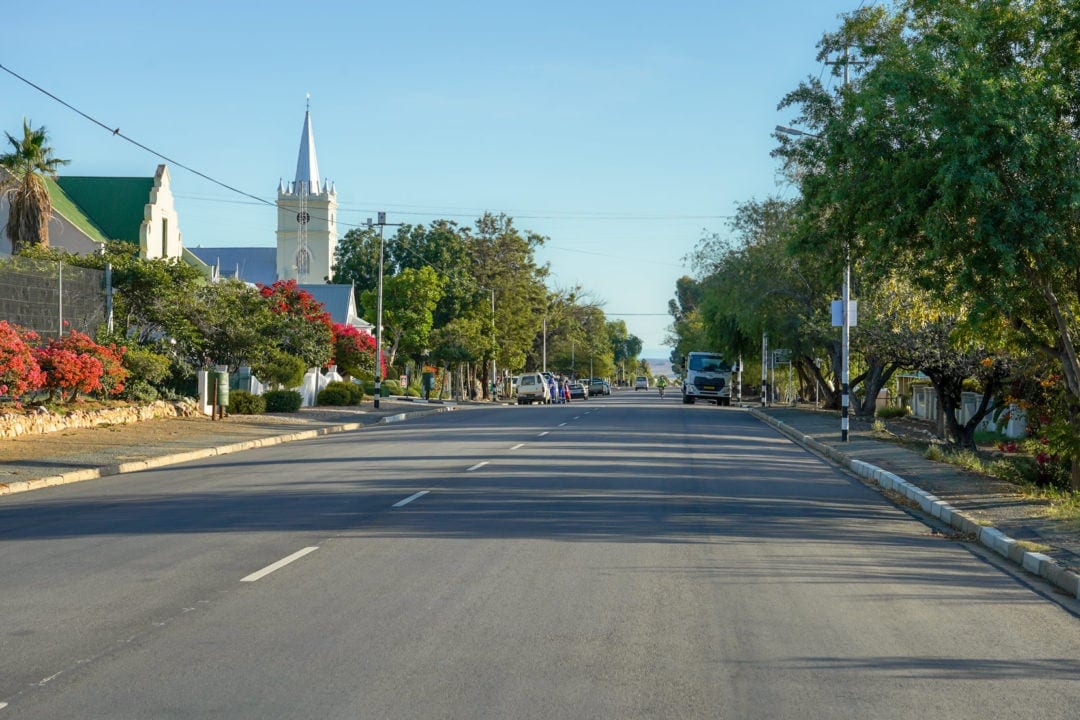
Parking
It is often safer to park in a shopping centre car park. Some will be barrier-entry with a pay-by-ticket system, and others will have free parking and security staff on duty in the car parks.
A common sight are locals in the car park wearing a fluoro vest who offer to watch your car. These aren’t official parking attendants but do this to earn a small income.
It gives a little peace of mind; however, don’t expect the attendant to protect your vehicle from a robbery. As a thank you, it is usual to give them between two and five Rand on your return.
Note: When driving in South Africa, it’s illegal to park facing in the wrong direction, therefore if you see a bay on the right-hand side of the road, you can’t cross over and park facing the traffic.
Extra Safety Tips – What To Watch Out For On South African Roads
1. Watch Out For Pedestrians On The Road
On South African roads, you will see many pedestrians. It might seem that you are in the middle of nowhere, but you will still find someone walking along the side of the road. For many, walking is their only form of transport.
Be particularly aware of school children. There are rarely pavements and the children walk on the side of the highway — some as young as five and six. It is sad to note that around 40% of road traffic fatalities in South Africa are pedestrians.
2. Watch Out For Animals On The Road
Another danger you are likely to encounter while driving in South Africa is animals on the road. This likelihood increases if you drive at night and in rural areas.
Don’t be surprised to find cattle, goats, sheep or antelope wandering along the roads or if you come face to face with a troop of baboons ambling across the road.
On one occasion, we encountered a couple of male baboons sunbathing on the road, and they weren’t too pleased that we wanted to pass.
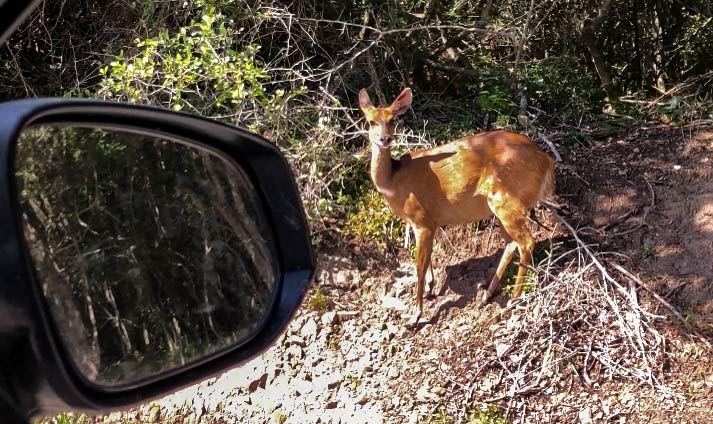
Driving In South Africa’s National Parks, Game Parks and Nature Reserves
For many, travelling to South Africa is enjoying its magnificent wildlife, so a trip to at least one Nature Reserve is likely on the cards.
When driving in these wilderness areas, it is important to follow the following protocols:
- You must remain in your vehicle at all times unless at a designated safe area
- Observe the speed limit of the park you are in—it is usually a maximum of 50km/hr on tar and 30 to 40km on gravel roads.
- Remain on the park’s roads and do not go off-road — the ecosystems are fragile
- Make sure you are aware of the park’s gate times and are out of the park by the required times
- Do not feed the animals. It can be a serious offence and is detrimental to animals’ health. Also, if they get used to humans feeding them, they are more likely to approach others and may get aggressive.
- Turn off your engine when you are at a sighting or near animals. Not only does the noise disturb them, but you need quiet to hear the animal noises.
- Remain still and avoid sudden movement that can sook an animal, and maintain quiet inside your vehicle
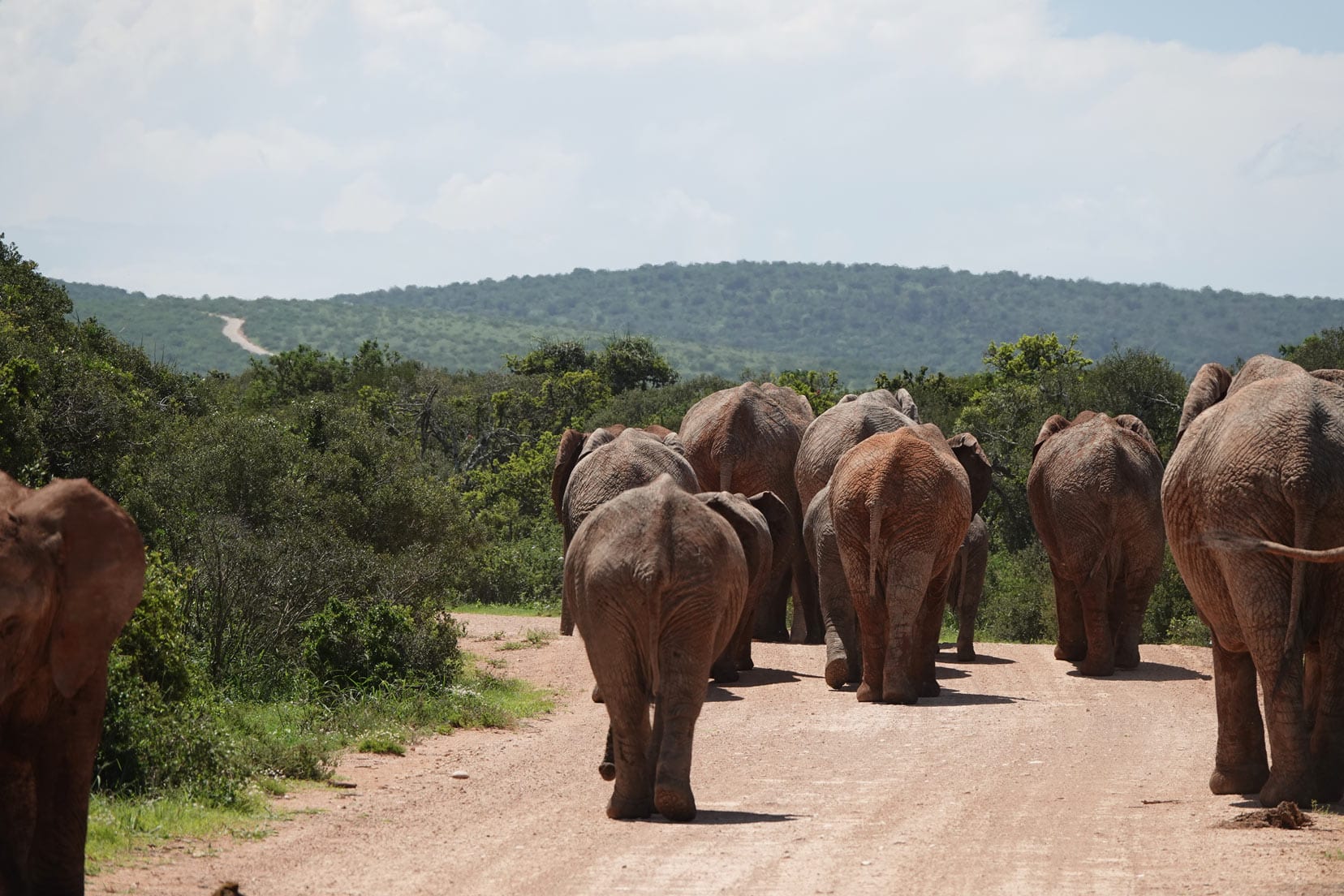
Read more about the following Nature Reserves, National Parks and animal parks we have visited in South Africa:
- Self-Drive Kruger National Park
- The Amazing Animals in Kruger National Park
- Beautiful Birds of Kruger
- Rhino and Lion Nature Reserve – Safari in the Suburbs
- Klaserie Nature Reserve -Everything You Need to Know
- Monkeyland, Plettenberg Bay: Furry Friend Afoot
- An Australian’s Take on Life in the South African Bush (Klaserie Nature Reserve)
Vehicle Considerations: Choosing Your Vehicle
The type of vehicle you choose to drive in South Africa depends to a certain degree on your itinerary, your budget and the level of comfort you like.
For us, we knew we wanted to explore as much as possible while in Africa on our open-ended road trip. Therefore, choosing a 4×4 was a top priority.
We also had a limited budget, so although a 4×4 motorhome or a 4×4 car with a 4×4 caravan would have been wonderful, the budget just wouldn’t stretch that far.
Also, as our trip may encompass a few years, it was a no-brainer for us to buy rather than rent. Needing to limit accommodation costs, we chose a Hilux 4×4 camper with a pop-up tent on top.
Depending on your own travel plans, we’ve included options and links to help you research costs below.
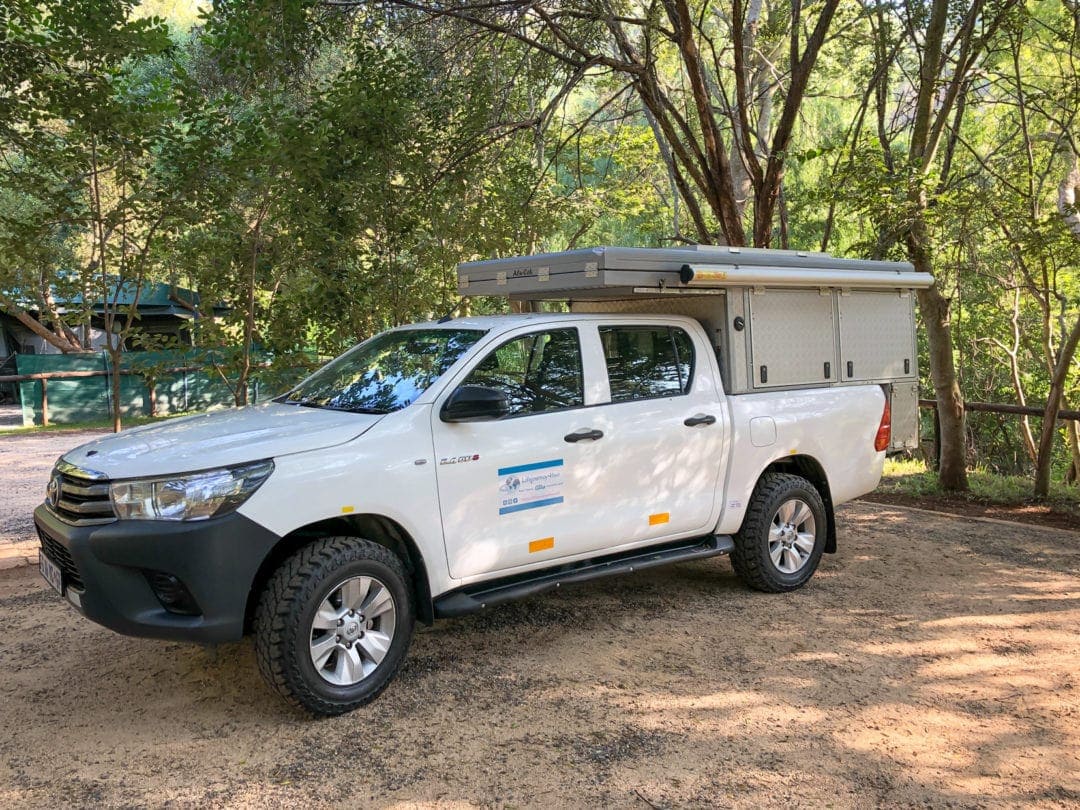
Vehicle Options
- Hire/buy a standard 2×2 car: Find a deal at DiscoveryCars. com
- Hire/buy a Bush Camper much like ours: Contact Bushlore, South Africa, for a quote
- Hire a bush camper from a range of operators: Find the best deal at Motorhome Republic (They deal with many different South African Fleets to find the best price and option for you).

4×4 Driving In South Africa
Although you can use a 2-wheel drive car while driving in South Africa, having a 4×4 enables you to travel roads that give you an enhanced experience of South Africa’s nature and scenery.
If you’re planning on driving in neighbouring countries, such as Namibia and Botswana, then a 4×4 is highly recommended as the roads are not as well maintained as those in South Africa plus you’ll likely want the off-road capability.
You can read all about how we bought our Hilux camper in South Africa, for our Africa Road Trip in our post: 4×4 South Africa: Top Consideration when Renting or Buying.
The post details how we bought the camper while we were in Australia, including a video walkthrough of the vehicle and how it all functions, such as how easy it is to put the tent up. It also details the modifications we completed to ensure our 4×4 Hilux was tip-top for our trip.
Hiring/Buying A 4-Wheel Drive In South Africa
If you are taking a road trip or planning a safari in South Africa, you could hire a 4×4 vehicle or a 2×4.
We bought our Hilux Bush Camper through a company called ‘Bushlore’. They rent out vehicles, offer a buy-back scheme, and sell their ex-rental 4×4 vehicles.
Their 4-wheel drives are mainly converted Toyota Hilux and Toyota Land Cruisers, which are perfect for driving in South Africa and beyond.
Bushlore is about a half-hour drive from Johannesburg’s Main airport, OR Tambo, so it is particularly well located. We were extremely impressed with their service as we researched and bought the vehicle from overseas – sight unseen.
On arrival, everything was just as discussed.
In addition, their aftercare service was fantastic. Our Hilux Camper had a one-month warranty, and they fixed or paid for us to have fixed all the teething problems we had.
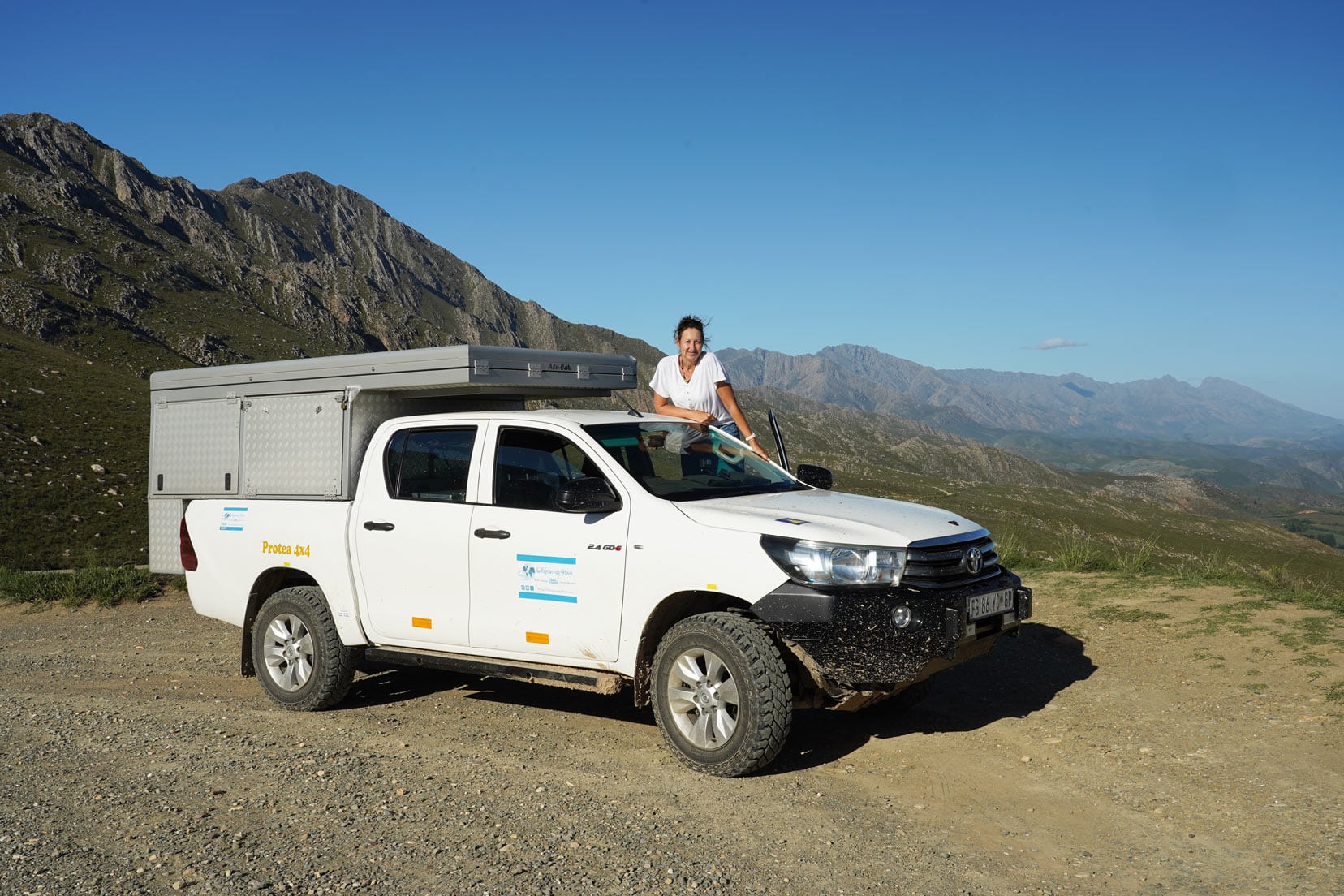
Vehicle Considerations: Hiring/Buying, Arriving From Overseas
- Take jag lag into consideration.
If you are arriving from overseas and likely to have jet lag (we arrived from Australia and felt jet-lagged for about 3 days), book into a nearby hotel for a few days to recover and get your bearings.
South Africa is not the place to drive tired and jet-lagged. We stayed at the Inani Hotel, which is right beside Bushlore.
- Get a thorough rundown of how your vehicle works and its accessories.
- If you are hiring a bushcamper make sure you are familiar the following:
- How to erect the tent
- How to operate the fridge
- How to hook up external power to the camper
- How to engage the vehicle’s 4-wheel drive
- Where your towing points are located
- Ask what you should check if the fridge doesn’t work or there’s a loss of power
- Where the following emergency equipment is stored:
- Jumper leads
- Spare tyre/s
- Jack and tools
- Tow rope (snatch straps)
- Emergency triangle
Top Tip: Take a video of the handover in case you forget something
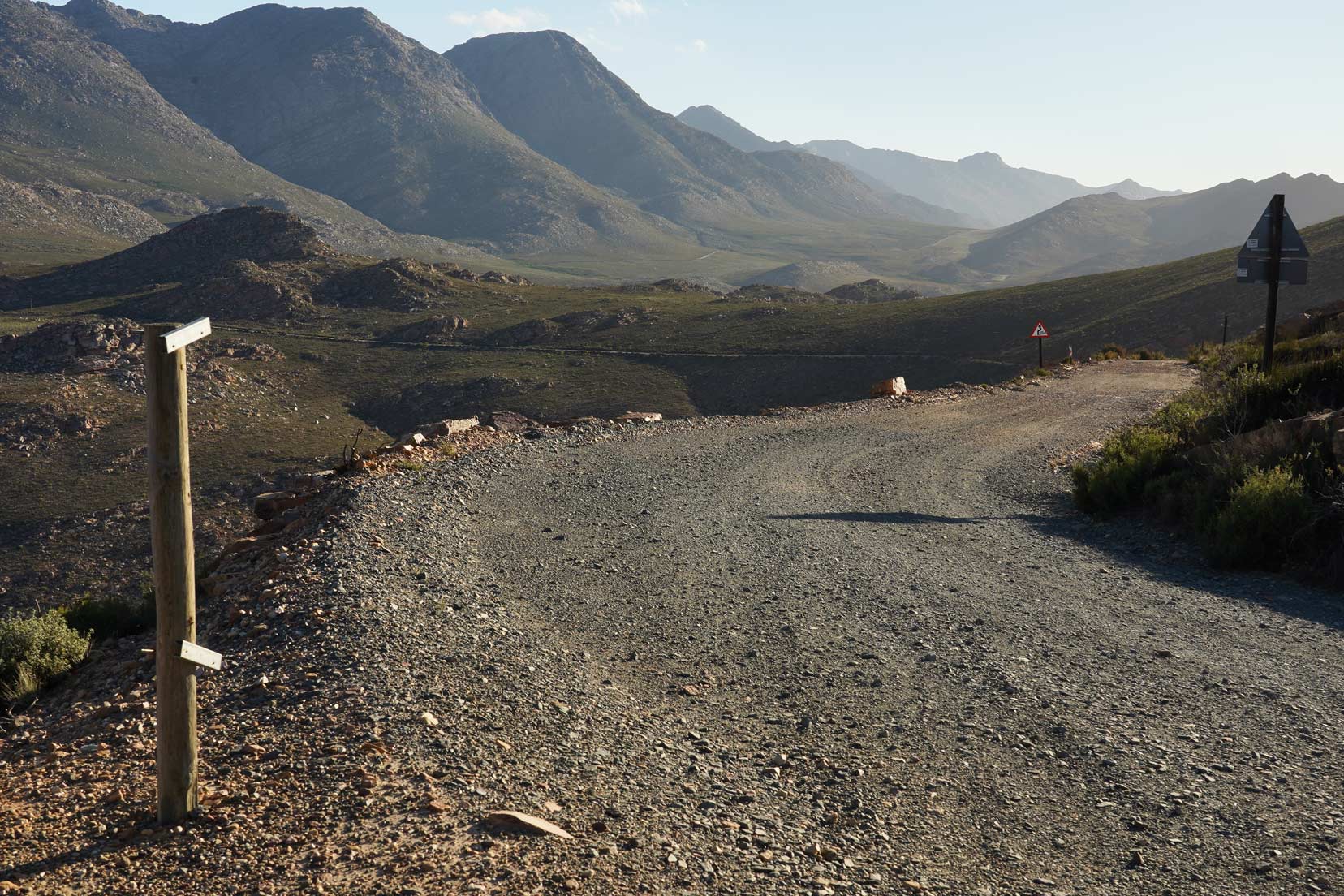
Consider A 4×4 Course Before Driving In South Africa
Once you have your vehicle and all of the necessary equipment that goes with your 4×4, you need to be familiar with how your new vehicle drives in different conditions.
We would recommend taking a course, particularly if you are not used to 4×4 driving. This relatively small outlay will make your driving in South Africa experience safer and more enjoyable.
You will feel more comfortable making driving decisions and have a better understanding of the vehicle.
Even though we were used to driving a 4×4 in Australia, we found the South African 4×4 course invaluable. Driving in the typical conditions we could encounter, was very helpful.
We booked our four-wheel driving course with Jannie from Protea 4×4. He gives useful advice on the specific areas you will be driving to in South Africa and the best routes to take.
The amazing bonus of the Protea 4×4 course was that it is inside the Rhino and Lion Nature Reserve. Therefore, we not only got to practice our 4×4 bush driving, but we did it within a wildlife park.
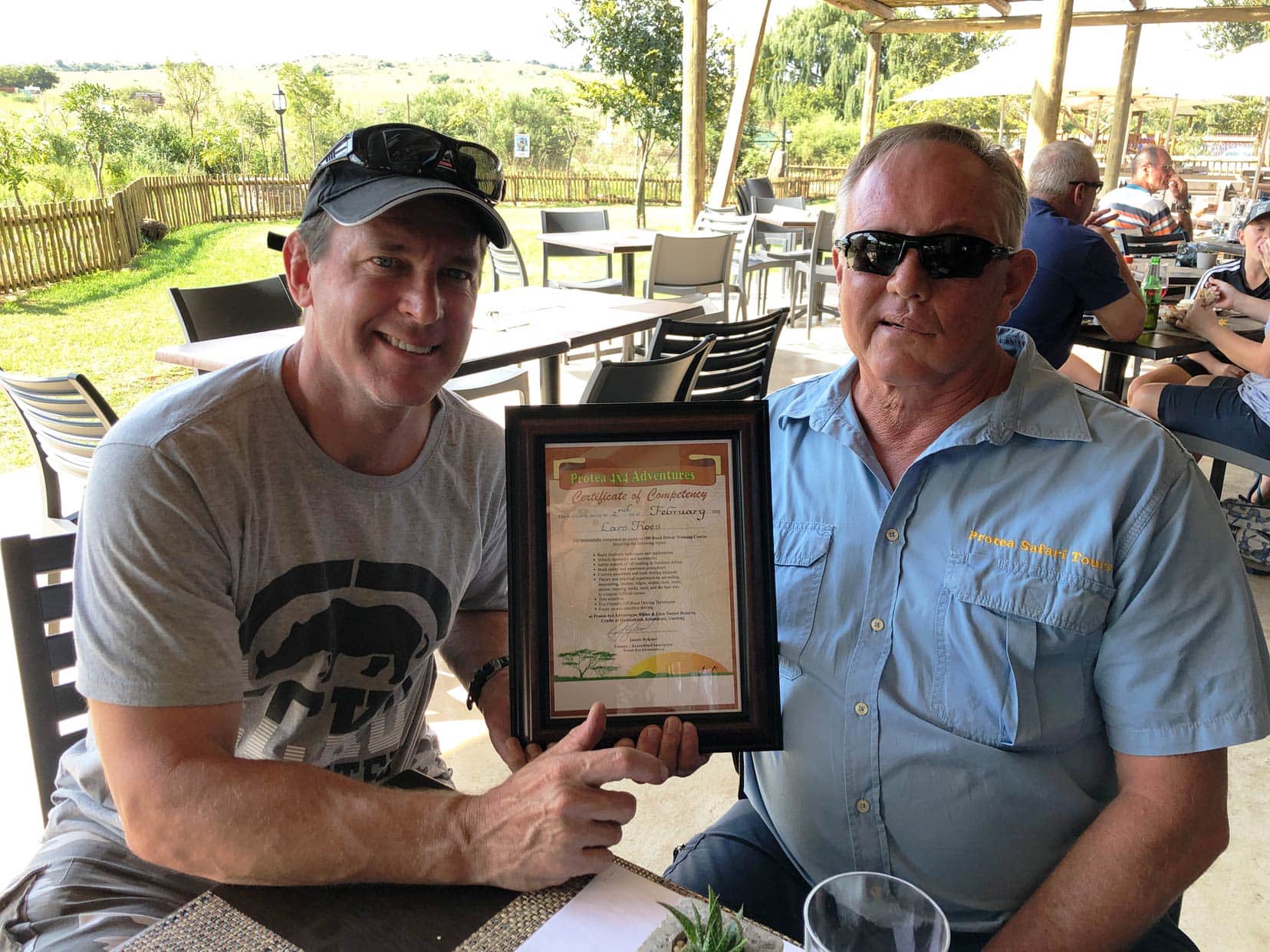
Off-Road Driving In South Africa
Recommended items to have in your 4×4 while off-road driving in South Africa
- Bottle jack – with appropriate load rating for the weight of your vehicle
- Air compressor to pump up tyres
- Tyre pressure gauge – vehicle tyre pressures will need to be changed and checked depending on the terrain
- Grass seed net to place over the radiator when driving through tall grass. Seeds can become lodged in the radiator and cause overheating.
- A snatch strap and shackles with appropriate load rating for the weight of your vehicle,
- You should have tow points at the front and rear of your vehicle
- High Lift Jack for when the Bottle jack is inadequate
- Recovery tracks/mats for when the vehicle is bogged
- Jumper leads with an adequate amp rating to start your vehicle
- Tyre plugs for a temporary fix of a flat tyre
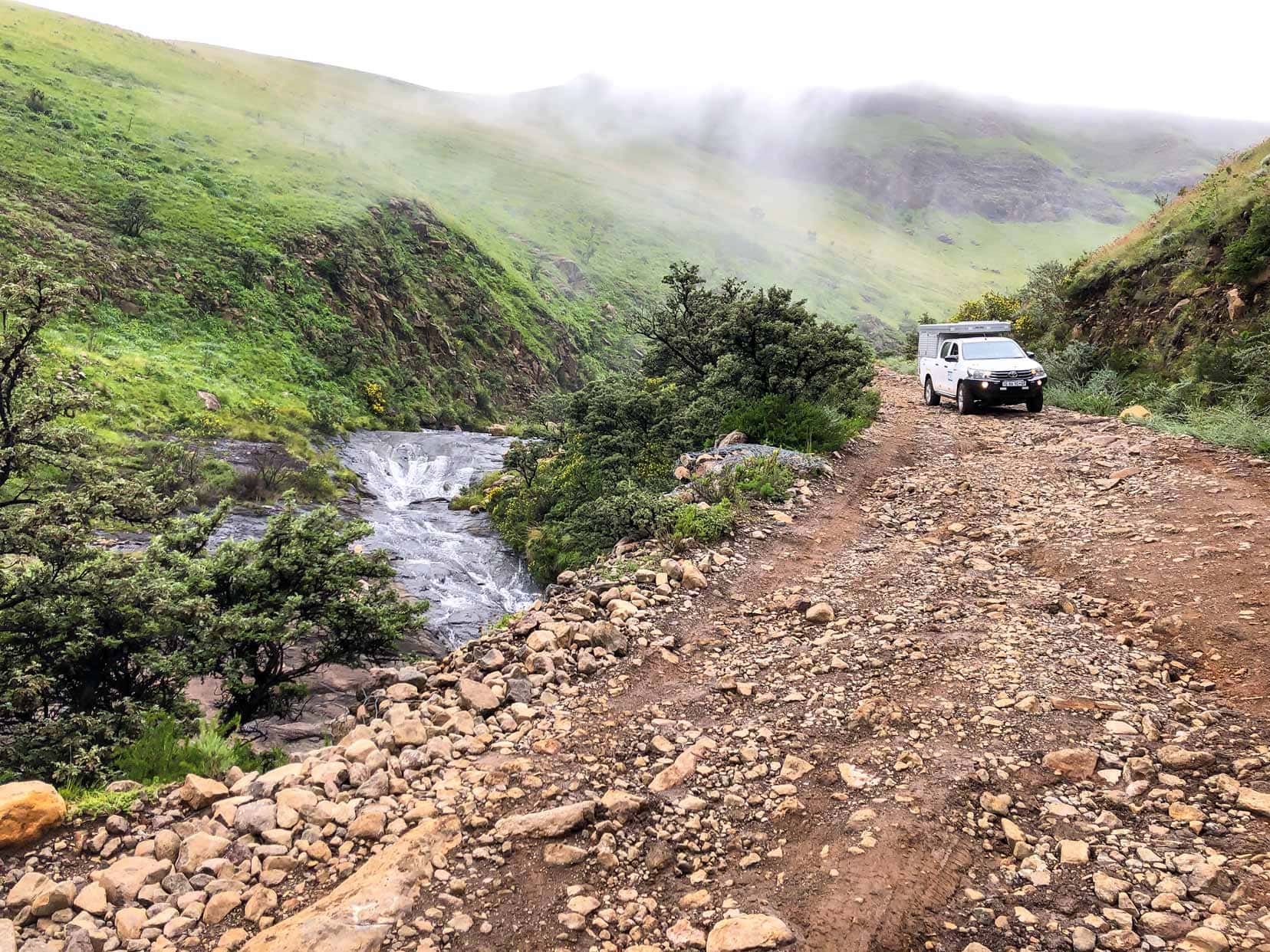
Off-Road Driving In South Africa Tips:
- Know the correct tyre pressure for your vehicle for tar, gravel and sand. For example, for our 3-tonne Hilux the tyre pressure we use is 2.8 bar for tar, 2.2 bar for gravel and 1.5 bar or less for sand]
- Use your hazard lights to advise other drivers that it is dangerous to overtake you
- Make sure you are at a dead stop when changing into or out of 4×4 Low
- Use Diff Lock to keep tyres from spinning when one or more tyres lift off the ground
- Check the water depth before driving through any waterways
- Seatbelts must be worn at all times unless you are undertaking a water crossing water then take off the belt for safety precautions and wind down windows
- If you are ever unsure as to whether it is safe to cross a waterway, wait for another vehicle to go ahead of you or find another route
- Keep 20 litres of drinking water at all times
- Check your grass net while driving through long grass every 15/20 minutes and remember to clear the grass around the hot exhaust and tail shaft to avoid combustion.
One of the most iconic 4×4 routes in South Africa is the adrenalin-fueled route along the Sani Pass which takes you from South Africa to the highest point in Africa, in the Mountain Kingdom of Lesotho.
Route Planning In South Africa
One of the best South Africa 4×4 maps is produced by Tracks4Africa. You can get a large double-sided map that is made of tear-proof and water-resistant paper, and it includes:
- Border post locations with their opening and closing times
- Distance and travel times table: realistic times unlike those given by Google Maps
- User-friendly scale, 1cm = 10km
- Lesotho and Swaziland, and some border areas of Namibia, Botswana, Zimbabwe and Mozambique
- Plenty of useful information annotated on the map like campsites, fuel stations etc.
Tracks4Africa Atlas
Another invaluable resource that we use for our South Africa route planning and navigation is the Tracks4Africa ‘Southern Africa Travellers Atlas’.
These maps are particularly helpful because they include off-road tracks and verified distances and driving times gathered by the 4×4 Tracks4Africa community.
Tracks4Africa also has a Travel Guide app which we use in conjunction with the paper copy map using a real-time GPS location to pinpoint your position.
This Atlas covers ten countries in Southern Africa and is specifically aimed at self-drive travellers. The countries included are: Angola, Botswana, Lesotho, Malawi, Mozambique, Namibia, South Africa, Eswatini, Zambia and Zimbabwe.
Crossing Borders: From South Africa
There are six countries that have borders with South Africa.
These are:
- Lesotho,
- Eswatini (previously Swaziland)
- Botswana,
- Namibia,
- Zimbabwe and
- Mozambique.
You’ve heard of the old saying, ‘Patience is a virtue, well, be prepared to be patient and polite at border crossings. Make sure you have the necessary documents readily available to show the border crossing guards.
Occasionally, rules may be lax, but always approach the border expecting strict adherence.
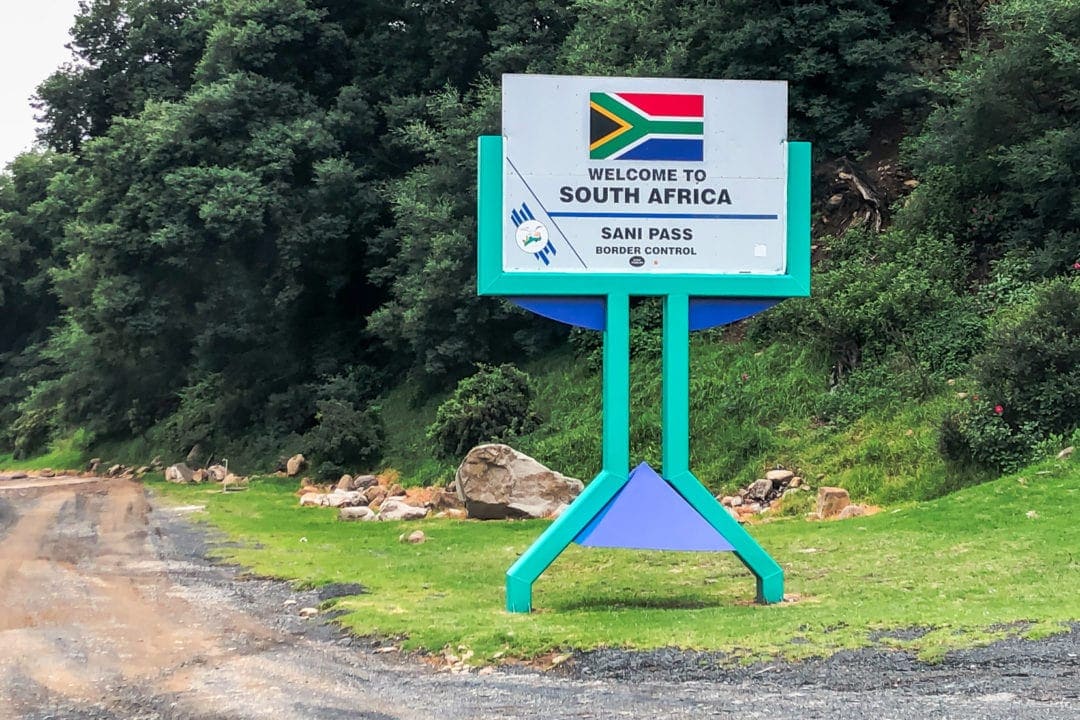
Border Crossing Requirements: South Africa
- You will need a valid passport with at least six months of validity remaining
- To drive you will need a valid driver’s licence and/or an International driver’s Licence
- An original or certified copy of the vehicle registration certificate. If the vehicle is financed by a bank, the registration certificate must be accompanied by a letter from the bank giving you the authorization to take the vehicle across the border and must indicate dates.
Both the bank letter and license papers should be signed by a Commissioner of Oaths. If you are not the vehicle’s registered owner, you will need an affidavit from the police giving you authorization from the owner to take the vehicle abroad.
The organisation will supply you with cross-border paperwork if you have hired the vehicle. - Border Fees – this is normally a small amount of local currency. Do not succumb to bribery. (Tip – sometimes, having a few cold cans of coke in your fridge/cooler can help calm a situation)
- If you’re travelling from South Africa across borders, vehicles should bear a ZA sticker that designates that they are from South Africa
- If you are arriving in South Africa from an area infected with yellow fever then you will need to show your Yellow Fever Vaccination Certificate
- Most countries bordering South Africa require you to have a set of red warning triangles
- Exiting South Africa to adjoining countries, you will need to comply with the import requirements, e.g. Entering Namibia from South Africa; we could not take dairy or uncooked meat and had to leave this at the border post.
- Returning to South Africa, you cannot import meat and dairy products at the border.
Check out the South African Government immigration services website for further information and the list of 72 land borders within South Africa.
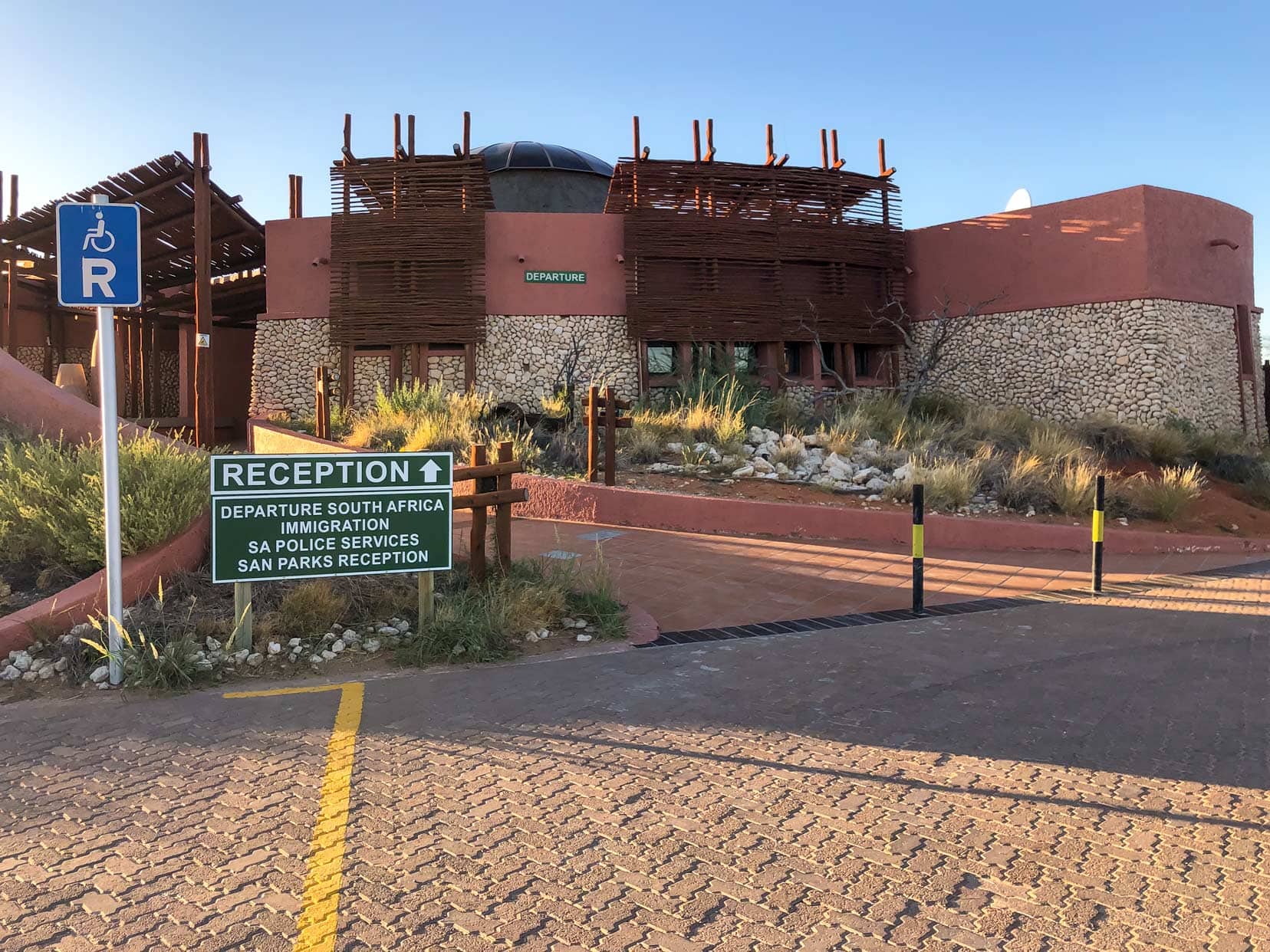
Health Precautions For Tourists In South Africa
As a tourist in South Africa, you must ensure that you have had the relevant and recommended vaccinations before arriving. Leave plenty of time to organise this, as some vaccinations require boosters before full immunity is reached.
The recommended vaccinations by the Centre for Disease Control (CDC ) are:
- Cholera
- Hep A and B
- Typhoid
- Measles
- All routine vaccinations up to date: MMR (Measles, Mumps and Rubella), Diptheria/Tetanus/Pertussis, Chickenpox, Polio.
- Yellow Fever Vaccination is required IF you are “arriving from countries with risk of yellow fever transmission, from Eritrea, Sao Tome and Principe, Somalia, Tanzania, Zambia, and for travellers having transited more than 12 hours through the airport of a country with risk of yellow fever transmission. ” World Health Organisation
Depending on where you will be driving in South Africa, you should consider taking Malaria prevention medication; however, this discussion needs to be with your doctor. At the time of writing, Malaria was in the areas listed below – check up-to-date information on this page of the CDC.
South Africa Malarial Areas:
- The border with Zimbabwe and Mozambique.
- Mopani, Vhembe, and the Waterberg district municipalities of Limpopo Province
- Ehlanzeni district municipality in Mpumalanga Province
- Umknanyakude in Kwazulu-Natal Province.
- Kruger National Park.
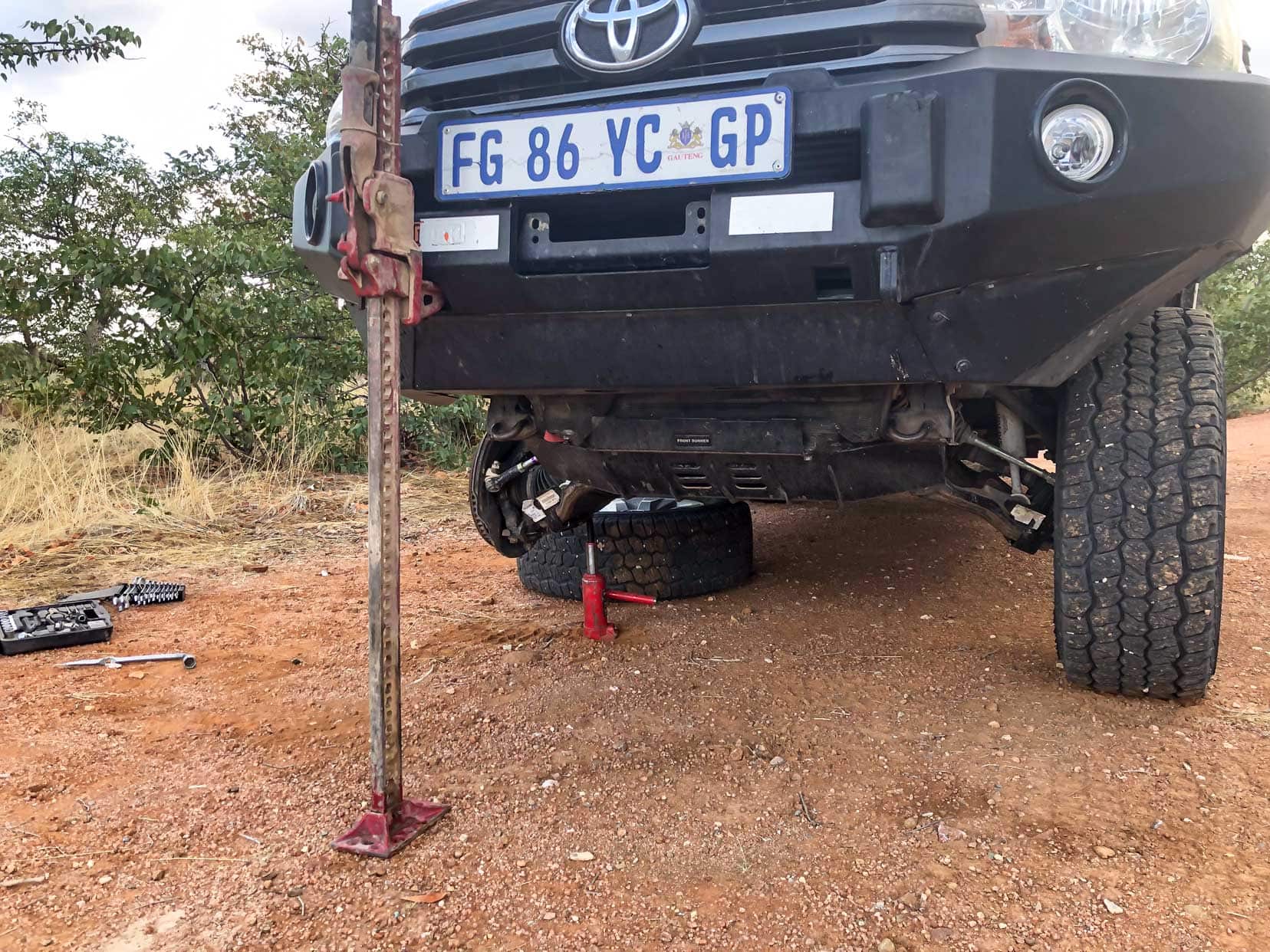
FAQ’s
Can I Use my Australian Driver’s License in South Africa?
Yes, you can use your Australian driver’s license in South Africa as it meets the country’s licence requirements: it is in English, has a photo ID, and has your signature.
Is It Safe to Drive Around South Africa as a Tourist?
Yes and No. Parts of the country are safer than other parts. Safety precautions will need to be taken, such as keeping windows up, doors locked and valuables out of sight and avoiding driving at night. Talking to the locals to ask where and what the problem areas are can you help you avoid any problems. It is best to avoid the townships.
Can a Foreigner Drive in South Africa?
Yes, a foreigner can drive in South Africa with the right documents. Many foreign driver’s licences are accepted as they meet the requirements: it needs to be in English, have a photo ID, and with your signature OR you have an international driver’s licence.
Can a Foreigner Buy A Car in South Africa?
Yes, a foreigner can buy a car in South Africa. You will need to apply in South Africa for a TRN (Traffic Registration Number) before you can purchase or have a vehicle registered in your name. Here’s how we were able to obtain a TRN as foreigners in South Africa.
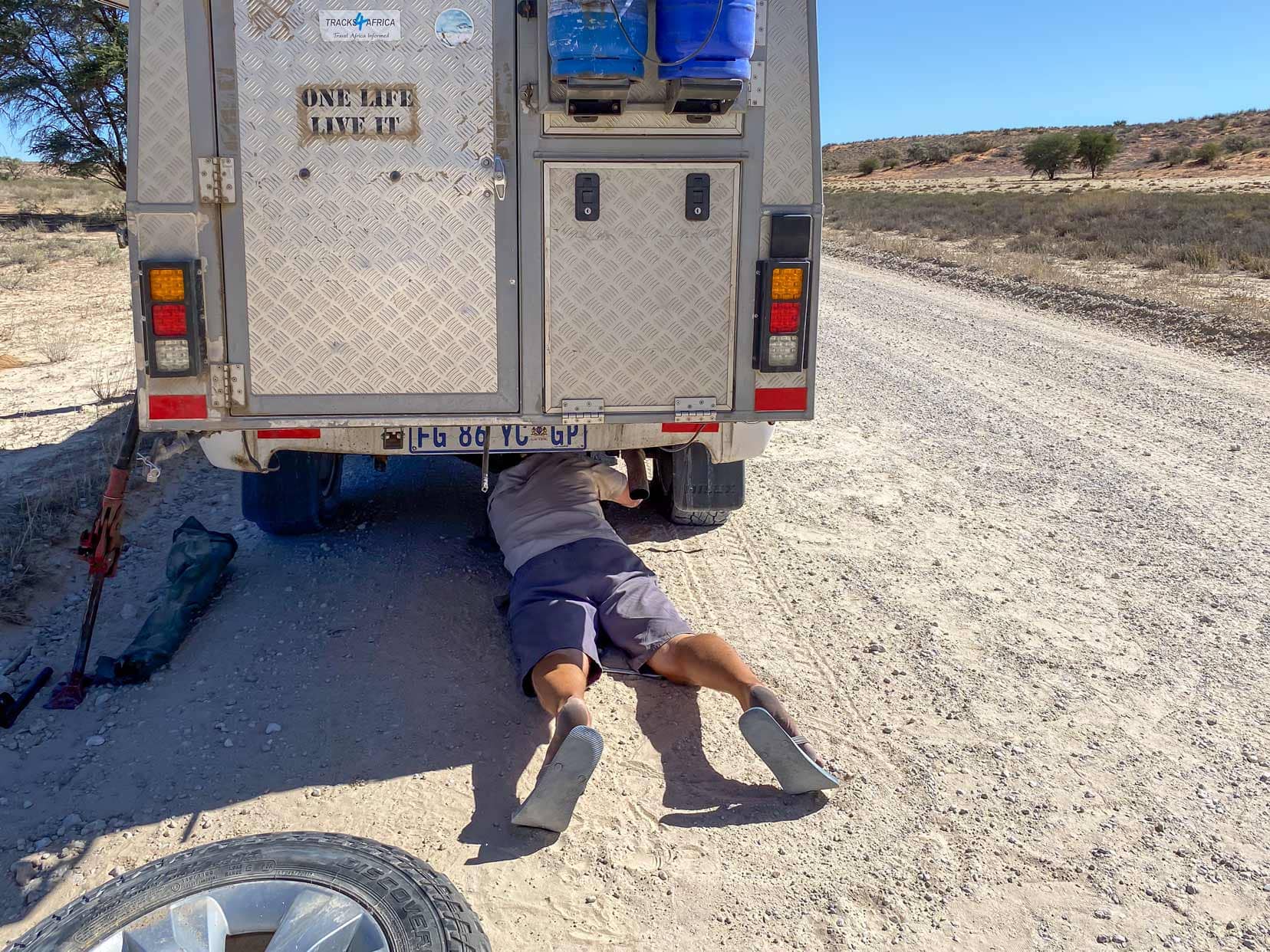
Driving in South Africa … That’s A Wrap
Navigating the roads of South Africa can be a remarkable adventure filled with breathtaking landscapes and unique cultural encounters. By following the detailed guidelines and safety tips provided in this guide, you can ensure a safe and enjoyable journey.
Always remember to carry the necessary documents, stay alert and be prepared for the unexpected. Whether you’re cruising through bustling cities or exploring remote scenic routes, South Africa offers an unforgettable driving experience.
Drive safely and enjoy every mile of your South African adventure!
Have you visited South Africa before? Have you had any driving experiences (good or bad) in SA? We’d really like to hear your take on it.
Save and Pin for Later
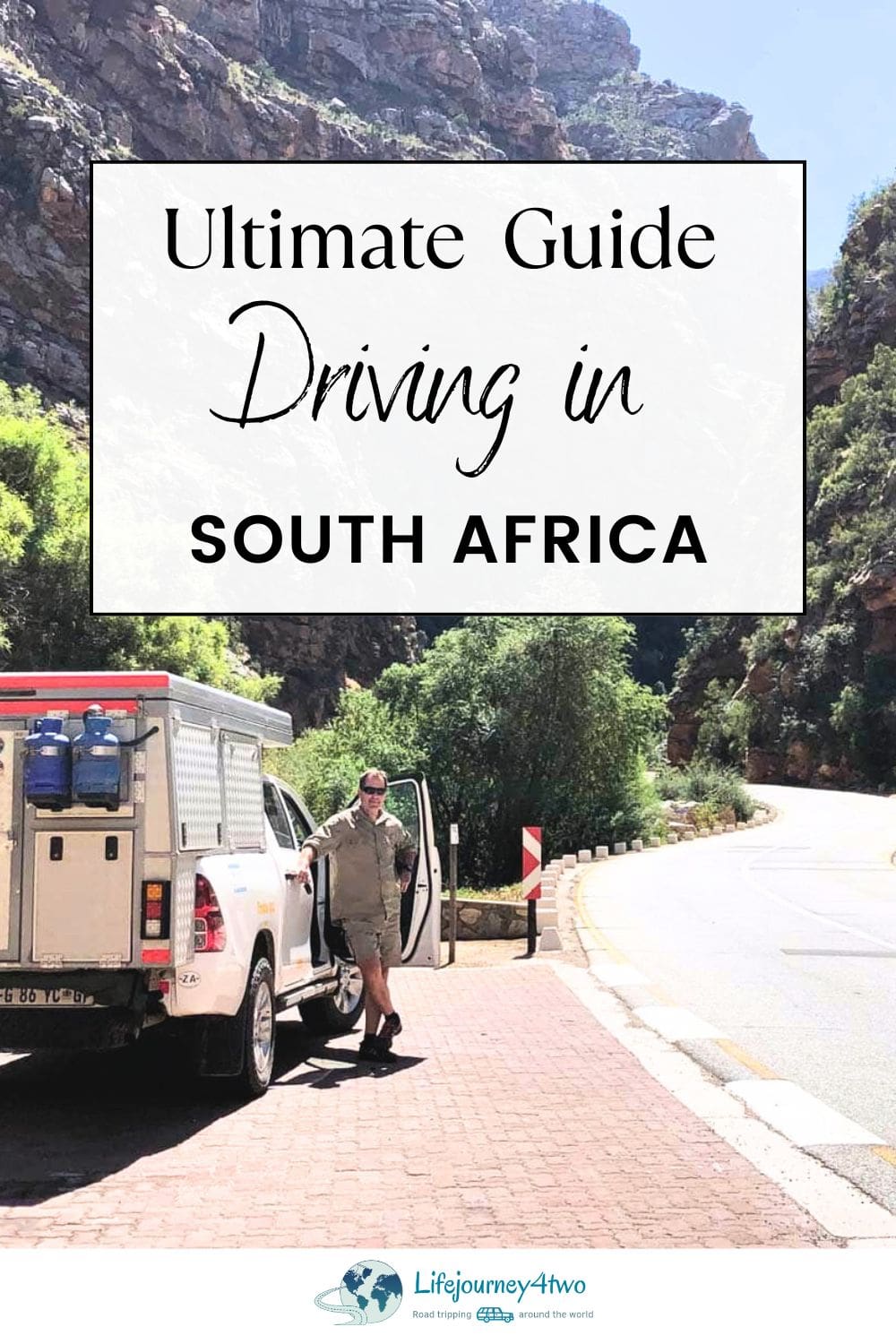
YOU MAY ALSO BE INTERESTED IN READING:
- Driving the Sani Pass, Lesotho
- 21 Things to do in Prince Albert and its Surrounds, Western Cape
- 3 Fantastic Western Cape Mountain Passes
- Lesotho Road Trip – Crossing the Mountain Kingdom
Planning Your Travels?
These are the travel resources we recommend and use when planning our trips.
- 🚘 Car Hire: We use DiscoverCars.com
- Motorhome/Campervan Rental: We highly recommend the Motorhome Republic
- 🪪 Order your International Driver’s Licence online here
- 🛏 Book Accommodation: We use Booking.com to find accommodation that suits our budget
- 🐶 Pet Sitting/Pet Sitters: Check Out TrustedHousesitters here (Use our Discount code: LIFEJOURNEY25 for 25% off. )
- Activities and Experiences: Get Your Guide and Viator
- Travel Insurance: Safetywing or World Nomads
- 🥾 Travel Gear and Accessories: Check out our top picks here — Lifejourney4two page on Amazon
For a more thorough list, visit our Travel Resources page here.

